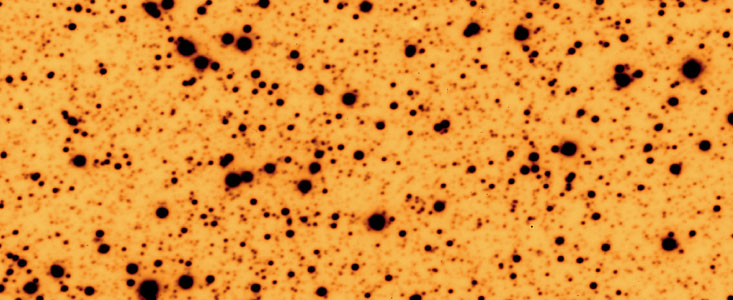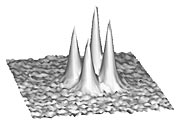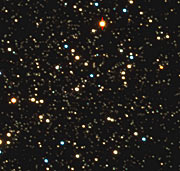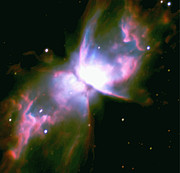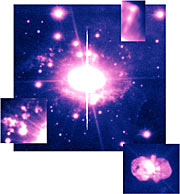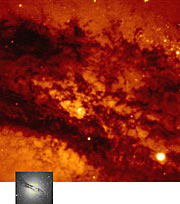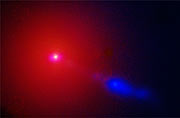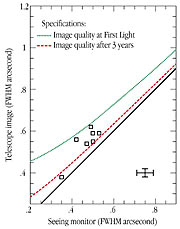Lehdistötiedote
A Great Moment for Astronomy
VLT First Light Successfully Achieved
27. toukokuuta 1998
The European Southern Observatory announces that First Light has been achieved with the first VLT 8.2-m Unit Telescope at the Paranal Observatory. Scientifically useful images have been obtained as scheduled, on May 25 - 26, 1998.
A first analysis of these images convincingly demonstrates the exceptional potential of the ESO Very Large Telescope. Just one month after the installation and provisional adjustment of the optics, the performance of this giant telescope meets or surpasses the design goals, in particular as concerns the achievable image quality. Exposures lasting up to 10 minutes confirm that the tracking, crucial for following the diurnal rotation of the sky, is very accurate and stable.
It appears that the concept developed by ESO for the construction of the VLT, namely an actively controlled, single thin mirror, yields a very superior performance.
In fact, the angular resolution achieved even at this early stage is unequalled by any large ground-based telescope.
The combination of large area and fine angular resolution will ultimately result in a sensitivity for point sources (e.g. stars), which is superior to any yet achieved by existing telescopes on Earth.
The present series of images demonstrate these qualities and include some impressive first views with Europe's new giant telescope. After further optimization of the optical, mechanical and electronic systems, and with increasing operational streamlining, this telescope will be able to deliver unique astronomical data of the highest quality. The commissioning and science verification phases of the complex facility including instruments will last until April 1, 1999, at which time the first visiting astronomers will be received.
The full significance of this achievement for astronomy will take time to assess.
For Europe, this is a triumph of the collaboration between nations, institutions and industries. For the first time in almost a century, European astronomers will have at their disposal the best optical/infrared telescope in the world.
We can now look forward with great expectations to the realization of many exciting research projects.
The First Light Images
Images of various celestial objects were obtained with the VLT CCD Test Camera, some of which are included in a new series, First Astronomical Images from the VLT UT1, that you can see in the right column on this page.
None have been subjected to image processing beyond flat-fielding (to remove variations of the digital detector sensitivity over the field) and cosmetic cleaning. They all display the recorded image structure, pixel by pixel. A detailed evaluation with accompanying explanations is presented in the figure captions.
1. Omega Centauri Tracking Tests
This 10-minute image demonstrates that the telescope is able to track continuously with a very high precision and thus is able to take full advantage of the frequent, very good atmospheric conditions at Paranal. The images of the stars in this southern globular cluster are very sharp (0.43 arcsec) and are perfectly round, everywhere in the field.
2. The Quadruple Clover Leaf Quasar
This 2-minute exposure of the well-known Clover Leaf quasar, a quadruple gravitational lens in which the largest distance between two components is only 1.3 arcsec, was obtained during a period of excellent seeing (0.32 arcsec) measured with a seeing monitor at the top of Paranal. The recorded angular resolution of just 0.38 arcsec demonstrates near-perfect optical quality of the telescope .
3. The Central Area of Globular Cluster M4
This is a colour composite of a field near the centre of the nearest globular cluster. At a seeing of 0.53 arcsec, the blue exposure reaches magnitude B = 24 in only 2 minutes (at signal-to-noise ratio = 5) in a bright sky. A simple extrapolation shows that B ~ 28 would be reached in a 1-hour exposure in a dark sky. The large mirror surface of the VLT UT1 and its ability to produce very sharp images, ensures that faint objects may be observed extremely efficiently.
4. Fine Structure of NGC 6302
This beautiful colour picture is a composite of three exposures through broad-band blue, green and red filters, lasting a total of 25 minutes. It shows the great complexity of this planetary nebula. It also demonstrates the exceptional efficiency with which features of faint surface brightness can be recorded with the VLT . Strong radiation from a dying star in a binary system at the centre impacts on the surrounding material that has been thrown out earlier from the system.
5) High-velocity Ejecta in Eta Carinae
This fine picture was obtained during an exposure lasting only 10 seconds. It shows fine structures around this very active object in a detail never before achieved with any ground-based telescope . In the lower insert, a short exposure of the central Homunculus Nebula (seeing 0.38 arcsec) provides a clear view of the three-dimensional structure of this bipolar object.
6. The Dust Band in Centaurus A
An amazing amount of faint details is shown in this high-resolution exposure (0.49 arcsec) of the central dust band in the nearby, southern galaxy Centaurus A, obtained through a broad-band red filter and lasting only 10 seconds. The VLT Unit Telescopes will be able to image many other galaxies in similar detail.
7. The Energetic Jet in Messier 87
The First Light took place during the night of May 25 - 26, 1998. Following a short interval of reasonable observing conditions, less optimal atmospheric conditions were encountered. The present photo, a three-colour composite (ultraviolet, blue, green) of the central region of the giant elliptical galaxy Messier 87 in the Virgo Cluster, was obtained during this night.
8. Total Optical Control
The 8.2-m main and the 1.1-m secondary mirrors of the VLT Unit Telescopes are completely computer-controlled by means of an Active Optics system. In this way, the shape of the mirror can be optimized very quickly for a given observational purpose. This sequence of 9 images illustrates how the appearance of a stellar image at the focal plane is fully controllable. Fast and thorough optical adjustment ensures the best possible optical quality at all times .
9. Image Quality of the VLT
This diagram demonstrates that First Light specifications have been fully met and, more impressively, that the actual VLT performance is sometimes already within the more stringent specifications that were expected to be fulfilled only three years from now.
The final steps before "First Light"
The final, critical testing phase commenced with the installation of the 8.2-m primary (at that time still uncoated) Zerodur mirror and 1.1-m secondary Beryllium mirror during the second half of April. The optics were then gradually brought into position during carefully planned, successive adjustments.
Due to the full integration of an advanced, active control system into the VLT concept, this delicate process went amazingly fast, especially when compared to other ground-based telescopes. It included a number of short test exposures in early May, first with the Guide Camera that is used to steer the telescope. Later, some exposures were made with the Test Camera mounted just below the main mirror at the Cassegrain Focus, in a central space inside the mirror cell. It will continue to be used during the upcoming Commissioning Phase, until the first major instruments (FORS and ISAAC) are attached to the UT1, later in 1998.
The 8.2-m mirror was successfully aluminized at the Paranal Mirror Coating facility on May 20 and was reattached to the telescope tube the day thereafter. Further test exposures were then made to check the proper functioning of the telescope mechanics, optics and electronics.
This has lead up to the moment of First Light , i.e. the time when the telescope is considered able to produce the first, astronomically useful images. Despite an intervening spell of bad atmospheric conditions, this important event took place during the night of May 25 - 26, 1998, right on the established schedule.
Linkit
Tiedotteesta
| Tiedote nr.: | eso9820 |
| Legacy ID: | PR 06/98 |
| Nimi: | Bug Nebula, Centaurus A, Cloverleaf quasar, Eta Carinae, First Light, H 1413+117, Messier 4, Messier 87, NGC 4485, NGC 5128, NGC 6302, Omega Centauri, Spinstars |
| Tyyppi: | Milky Way : Star : Type : Wolf-Rayet Milky Way : Star : Grouping : Cluster : Globular Milky Way : Nebula : Type : Planetary Local Universe : Galaxy : Type : Elliptical Local Universe : Galaxy : Component : Central Black Hole Early Universe : Galaxy : Type : Gravitationally Lensed Early Universe : Galaxy : Activity : AGN : Quasar Unspecified : Star Unspecified : Technology : Observatory : Telescope |
| Facility: | Very Large Telescope |
Our use of Cookies
We use cookies that are essential for accessing our websites and using our services. We also use cookies to analyse, measure and improve our websites’ performance, to enable content sharing via social media and to display media content hosted on third-party platforms.
ESO Cookies Policy
The European Organisation for Astronomical Research in the Southern Hemisphere (ESO) is the pre-eminent intergovernmental science and technology organisation in astronomy. It carries out an ambitious programme focused on the design, construction and operation of powerful ground-based observing facilities for astronomy.
This Cookies Policy is intended to provide clarity by outlining the cookies used on the ESO public websites, their functions, the options you have for controlling them, and the ways you can contact us for additional details.
What are cookies?
Cookies are small pieces of data stored on your device by websites you visit. They serve various purposes, such as remembering login credentials and preferences and enhance your browsing experience.
Categories of cookies we use
Essential cookies (always active): These cookies are strictly necessary for the proper functioning of our website. Without these cookies, the website cannot operate correctly, and certain services, such as logging in or accessing secure areas, may not be available; because they are essential for the website’s operation, they cannot be disabled.
Functional Cookies: These cookies enhance your browsing experience by enabling additional features and personalization, such as remembering your preferences and settings. While not strictly necessary for the website to function, they improve usability and convenience; these cookies are only placed if you provide your consent.
Analytics cookies: These cookies collect information about how visitors interact with our website, such as which pages are visited most often and how users navigate the site. This data helps us improve website performance, optimize content, and enhance the user experience; these cookies are only placed if you provide your consent. We use the following analytics cookies.
Matomo Cookies:
This website uses Matomo (formerly Piwik), an open source software which enables the statistical analysis of website visits. Matomo uses cookies (text files) which are saved on your computer and which allow us to analyze how you use our website. The website user information generated by the cookies will only be saved on the servers of our IT Department. We use this information to analyze www.eso.org visits and to prepare reports on website activities. These data will not be disclosed to third parties.
On behalf of ESO, Matomo will use this information for the purpose of evaluating your use of the website, compiling reports on website activity and providing other services relating to website activity and internet usage.
Matomo cookies settings:
Additional Third-party cookies on ESO websites: some of our pages display content from external providers, e.g. YouTube.
Such third-party services are outside of ESO control and may, at any time, change their terms of service, use of cookies, etc.
YouTube: Some videos on the ESO website are embedded from ESO’s official YouTube channel. We have enabled YouTube’s privacy-enhanced mode, meaning that no cookies are set unless the user actively clicks on the video to play it. Additionally, in this mode, YouTube does not store any personally identifiable cookie data for embedded video playbacks. For more details, please refer to YouTube’s embedding videos information page.
Cookies can also be classified based on the following elements.
Regarding the domain, there are:
- First-party cookies, set by the website you are currently visiting. They are stored by the same domain that you are browsing and are used to enhance your experience on that site;
- Third-party cookies, set by a domain other than the one you are currently visiting.
As for their duration, cookies can be:
- Browser-session cookies, which are deleted when the user closes the browser;
- Stored cookies, which stay on the user's device for a predetermined period of time.
How to manage cookies
Cookie settings: You can modify your cookie choices for the ESO webpages at any time by clicking on the link Cookie settings at the bottom of any page.
In your browser: If you wish to delete cookies or instruct your browser to delete or block cookies by default, please visit the help pages of your browser:
Please be aware that if you delete or decline cookies, certain functionalities of our website may be not be available and your browsing experience may be affected.
You can set most browsers to prevent any cookies being placed on your device, but you may then have to manually adjust some preferences every time you visit a site/page. And some services and functionalities may not work properly at all (e.g. profile logging-in, shop check out).
Updates to the ESO Cookies Policy
The ESO Cookies Policy may be subject to future updates, which will be made available on this page.
Additional information
For any queries related to cookies, please contact: pdprATesoDOTorg.
As ESO public webpages are managed by our Department of Communication, your questions will be dealt with the support of the said Department.
